by Barry Rudolph
|
TC-Helicon VoiceTone Singles
by Barry Rudolph |
|
You can think of TC-Helicon's four new VoiceTone Singles as stomp pedal effects boxes for vocalists. Singers can now easily set up and enjoy modern studio-style digital processing for their live stage performances. Built using die-cast steel cases with
rubberized bases, the four VoiceTone Singles are: the T1 Adaptive Tone and Dynamics processor; C1 or HardTune & Correction pedal; the D1 is a Doubler & Detune unit; and R1 is a Vocal Tuned Reverb with many preset reverb settings. Up to four VoiceTone Singles may be interconnected, using the Singles Connect Kit, for building your own custom vocal effects pedal board. The kit includes a single 12-volt power supply with three daisy-chained power connectors, and three short XLR cables.

Microphones plug right into any of the VoiceTone pedals using a standard XLR connector and your soundman will like that the units all output to the appropriate male XLR jack for normal connection to the mic inputs of the PA system's mixer. Because they go inline with any standard mic and cable, they'll work on any stage and at any gig. And yes, all the Voice-Tone pedals have microphone phantom powering that solves a common problem a singer sometimes faces: because of the lack of onstage phantom powering, they can't use their favorite live condenser microphone.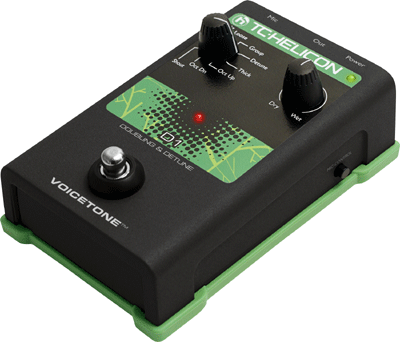
VoiceTone Single D1 Doubler & Detune Processor
On all VoiceTone pedals, there is an onboard mic gain control and a yellow/red LED indicator for getting a proper operating level no matter what mic you use. There is plenty of gain so you can use old-time, low output (but cool-looking) microphones and still provide a good signal and proper impedance to the PA system's console. All VoiceTone pedals are powered by an included wall-wart power supply so you'll need a small AC plug strip and extension cord for the gig or buy the aforementioned Singles Connect Kit. But you'll have the secure feeling that your vocal effects and sound quality do not depend on a suspect (and probably) weak nine-volt battery. Besides there is a lot of technology inside of these pedals and a nine-volt could never power it all.
I first tried out both the D1 Double and Detune and R1 Vocal Tuned Reverb pedals using both an old AKG D190E dynamic mic and a brand-new a Shure Beta 181 condenser (a phantom-powered studio and live mic) with good results. The D1 Double and Detune pedal sounded great and I immediately found the doubling effect, when set to either the Tight (whose output is 6-cents flat), Loose or Group presets, most effective when switched in at all times for lead vocals. I set the Wet/Dry control to the center-detent midway position except when I wanted a crazy amount of detune for certain moments in the song, I'd crank it to the fully wet side.
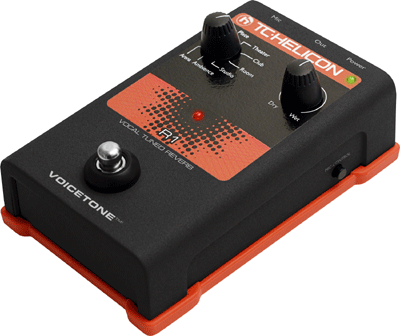 |
| VoiceTone Single R1 Vocal Tuned Reverb |
The D1 pedal has five more descriptively named presets: Detune has two output voices, one short delay and one tuned -12 cents flat; Thick also has two voices but they are +/-12cents apart; Oct Up has two voices both up the octave; while Oct down has the two both an octave down; lastly is Shout where you get both an octave up and an octave down voice to simulate the sound of two other singers in unison. Shout turns out to be great for aggressive Rock vocals. With the exception of Detune, all presets have a "humanize" component that quasi-randomizes the delay times to emulate real singers pitching together while singing in unison.
It gets even better with the Mic Control feature where you can manually toggled any of the pedals on/off remotely when using TC-Helicon's MP-75 Modern Performance vocal microphone. Being stomp pedals, they all have a sturdy footswitches to bypass their effect but the remote feature allows you to "kick in" a preset effect on certain notes and phrases right from the mic itself. You are no longer required to find the pedal on the floor to step on it--you can now switch a pedal in/out from anywhere on stage. To activate this remote control feature on any pedal (on "as needed basis"), just toggle a pushbutton on their right side.
The Mic Control feature is especially effective when using the R1 Vocal Tuned Reverb. You can selectively add any of the preset reverb treatments to certain words and/or sung phrases right from the mic's button. R1's eight presets are: Hall provides a large space with a moderate pre-delay; Plate is also a long reverb with pre-delay but with a brighter sound; Theatre is a darker sound that works well as a static effect—always on; the Club, Room and Studio presets are all shorter reverbs with none or very short pre-delays that vary in brightness and the amount and number of initial reflections. They are also good standard, always on presets that will thicken up thin voices. Ambience and Arena presets are much longer reverbs making them good for sporadic and splashy events—epic moments in your songs you'd like to further dramatize.
>
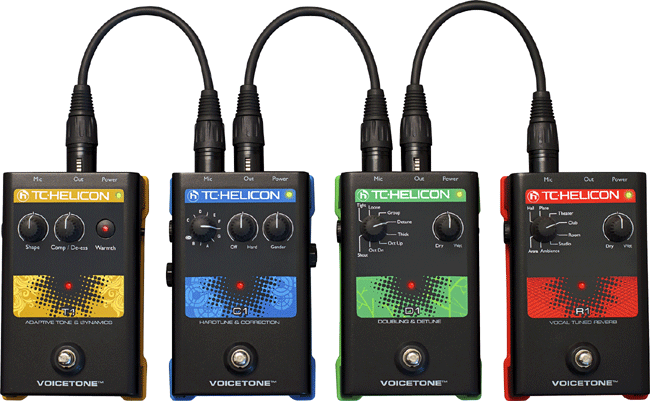 |
| VoiceTone Singles Connect Kit |
There is a second or so wait time when switching presets on the R1 but you can use that interruption to abruptly cut off a long reverb tail by switching from Arena to Studio to create the effect of a gated room. I listened to the sound of just the reverb only (no dry sound mixed in) and found it slightly duller than the dry or original input signal. This is a good thing because these reverbs are for filling out your vocal sound and not overly reactive to onstage splashy guitar and cymbal leakage into the singer's mic.
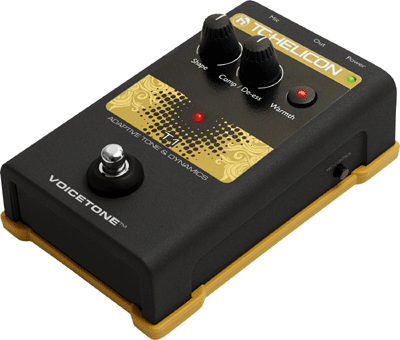 |
| VoiceTone Single T1 Adaptive Tone and Dynamics Processor |
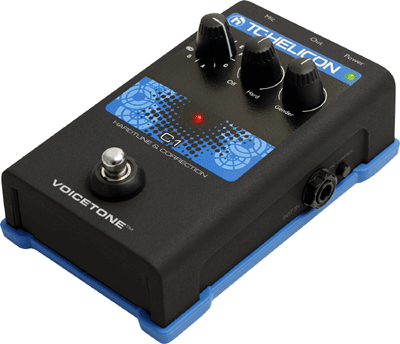 |
| VoiceTone Single C1 HardTune & Correction |
This EQ is not strident or severe but works to make up for a cheap microphone (set Shape to boost lows and roll-off highs) or an overall dull PA system vocal sound (set Shape to the right side for more brilliance and less low frequencies).
T1 combines a gentle compressor with a de-esser under the control of a single knob. The compressor tends to even out the volume of your loud and quiet singing moments. Moving the knob towards De-ess will reduce the punch of s, t, or any other hard consonant sounds. The center position is a good general setting for T1. If you engage the Warmth button, you'll get a very nice lift in the low frequencies that will fatten up your vocal on a thin-sounding PA or make up for bad microphone. It made my AKG D190E sound better than it has ever sounded--much warmer and fatter.
Saving it for last is my favorite of the four TC Helicon VoiceTone Singles pedals, the C1 HardTune & Correction unit. The C1 is a live vocal gentle pitch corrector that'll reign in problematic notes but will also work as an 'auto tune' effect. It hooks up like the other three VoiceTone Singles except there are also 1/4-inch instrument input and thru jacks for sending pitching information to it from a keyboard or guitar.
C1 also has a selector for manually setting the key to match your music. There are keys from C up to B in half step increments (C, C#, D, D#, E, F, F#, G, G#, A, A#, B). You also can switch the pedal to chromatic mode where it will track and correct pitch in any key. While in chromatic mode, the instrument input becomes active and I found a keyboard or synth seem to work the best when selecting a fixed key did not match the song.Besides the Key selector, C1 has a 'strength' control that varies from Off or no re-tuning leaving just an inherent and slight delay sound, all the way to Hard for getting your T-Pain on. For straight ahead tuning, leave this control in the center-detent position. The Gender control changes formants (the range and number of sonic components that represent its timbre--in this case the aural differences between male and female voices) to make you sound manlier or more girlie. Gender bending is good fun and useful for certain special effects in your songs.
All VoiceTone Singles have min-USB connectors to interface to your computer for registering and downloading the latest firmware updates and tips using the TC-Helicon VoiceSupport application. All four Helicon VoiceTone Singles are easy and intuitive to set up and adjust and none overly emphasize sibilance or present any technical problems for your soundman.
For any gig and any venue, large or small, all of the VoiceTone Singles offer immediate control over their sound and will enhance any singer's sound immediately with the least amount of set up hassle. But I'm warning you, keep an eye on them at the gig--your soundman might "accidentally" pack these up with his kit after the show!
Suggested MSRP prices are: T1 is $179, C1 sells for $235, D1 is $205, and the T1 sells for $205. Much more at: www.tc-helicon.com/.
|
|
|